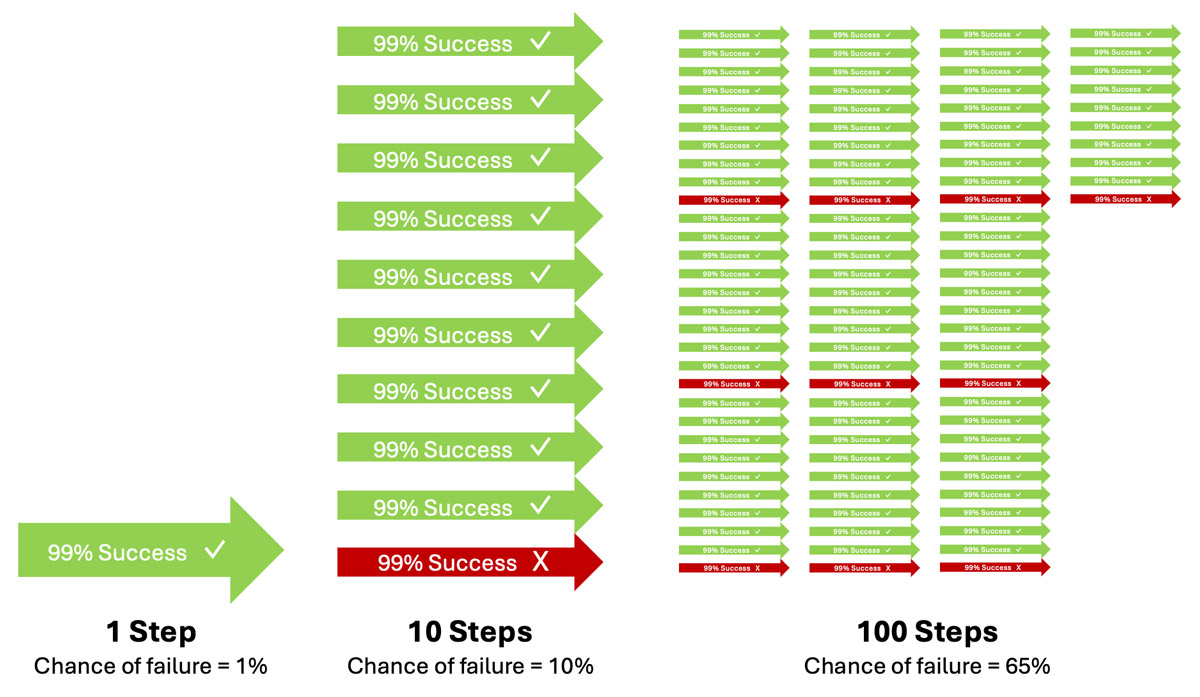If the word “agent” makes you think of tuxedos and martinis before tokens and context windows, you’re not alone. Hollywood taught us to picture a single, flawless operator, unflappable, omniscient, and never waiting on further instructions. The reality of AI is different, but no less useful. An AI agent will never walk the red carpet, but a round-the-clock roster of competent specialists for less than the cost of lunch is how you win without the theatrics.
Think of AI agents as field operatives you can actually hire. Each is built for a single mission, armed with just the tools it needs, and briefed with exactly the information required. You hand them a target, a timeline, and an exit condition. They come back with exactly what you asked for: a market scan distilled to three bullets, or a draft proposal turned around in under five minutes.
They don’t get tired. They don’t get bored. They just execute.
This is a shift in posture, not a surrender of control. You’re still James Bond’s M. You set objectives, establish the rules of engagement, and decide when to green-light or abort. The agents do the legwork: comb a codebase for security regressions, reconcile a month of expenses against policy, sweep a market for signals worth your attention. They don’t improvise the mission; they execute yours.
The win is in the granularity. You hate drudgery and context-switching; agents don’t. You burn out on repetitive checks; they thrive on them. Once you start thinking in missions, you stop dreaming about a single superintelligence and start building a dependable network of specialists. That’s where the leverage lives.
Forget the tux. Picture a clean queue of operations moving in parallel, each agent in its own safe house of context, each returning precise deliverables you can trust and act on. No capers. No melodrama. Just competent tradecraft at a price point that makes experimentation trivial and scale practical.
You don’t need a Bond. You need a bench.
What is an AI Agent?
Strip away the movie gloss and an AI agent is a specialized, autonomous worker. Narrow job. Clear mission. The exact tools it needs and nothing extra.
Think of a code reviewer with permanent security clearance. A financial reconciler who never forgets a policy. A research scout that combs 10-Ks and datasets in minutes, not days. You brief them, they run the op, they report back.
In technology terms, an AI agent is defined as a system or program that uses artificial intelligence techniques to perceive its environment, make decisions, and take actions autonomously to achieve specific goals. The key difference between an AI agent and a generic “chatbot” or “assistant” is scope and independence. Agents are trained for one role, can be deployed in parallel, and operate in isolated “safe houses” of context with no cross-contamination.
If a chatbot is your desk clerk, an agent is your field operative. They leave HQ, execute in the wild, and return with the goods you asked for.
And because each one is narrow by design, you can spin up a bench of them: a compliance officer here, a performance engineer there, a market analyst on the flank. All working in parallel, each accountable to its mission and its deliverable.
The 20-Step Rule
Even the best agent systems fail sometimes. A 99 percent success rate per step sounds reliable until you start stacking steps. At ten steps, one run in every ten fails. At a hundred, nearly two-thirds do.

That math shapes the playbook for running agents well. The longer the mission, the more chances for something to drift, mismatch, or break. Each extra step is another opportunity for:
- Context drift
- Tool mismatch
- Instruction ambiguity
- Environmental change
The advantage comes from keeping agent missions tight. Under 20 steps keeps the odds in your favor and the results dependable. That same discipline transforms the economics. A deep-dive market analysis that would cost $400 in analyst time can run for $3 in tokens. A competitive review that once took days can come back in minutes. You’re not just saving money, you’re collapsing timelines.
The playbook for building agents is simple:
- Short missions: Under 20 steps for maximum reliability.
- Clear deliverables: One defined output, no scope creep.
- Strategic human checkpoints: Review only where the cost of a miss is high.
- Fast iteration: Adjust immediately when results fall short.
Think of it as precision work, not long-haul deployment. In, execute, and out before overhead piles up. The orchestrator gives the order and instantly you have a security analyst combing code, a compliance officer checking policies, and a performance engineer profiling systems. All agents running at the same time, each in its own lane, without interference.
The highest leverage comes from the narrow, repeatable tasks where expertise is expensive, but the process is well defined. It’s the work people avoid but still need done right, for example:
- Market briefs
- Competitive analysis
- Technical documentation
- Policy checks
Start small. Test a contained workflow. Measure the results. Scale what works. That’s how you keep the math, and the money, on your side.
Build AI Agents Like a Handler
The best intelligence networks run on simple principles, and AI agents are no different. Start with domain specialists who know their job cold, and make sure every agent mission begins with a clean slate. No baggage from previous runs, no cross-contamination between assignments. Keep a clear chain of command with an orchestrator setting mission objectives, not dictating every move, and treat AI as a component in your system, not the system itself. It doesn’t matter if the AI made a mistake when it’s your name on the report. It’s always your responsibility.
Structure matters
When possible, launch new programs on fresh ground. If you have to integrate with existing systems, use vetted APIs. Web scraping should be a fragile last resort when nothing else will do. The structure matters more than the technology. Your orchestrator ensures the team stays on mission; the specialists handle execution.
Don’t forget your people
Keep humans in the loop where it matters most. Catching errors is important, but building trust and accelerating adoption might be the bigger win. People embrace what they help shape, and they resist what feels like a replacement.
Curate a team
Build your agent network like you’re coordinating operations, not automating busywork. Each agent should be rock-solid inside its scope, independent in execution, and clear about its role in the hierarchy. That’s how you scale without losing control.
Make It Look Easy
Reliability beats autonomy every time. Part of the craft is making complex operations feel simple. Your agent end-user should feel like they’re holding something magic, not paging through a mission briefing.
That means building the guardrails before they’re needed. Start by defining fallbacks for when things go wrong. Design agent responses that are clear and interpretable, with the complexity hidden underneath. The user doesn’t need to know about the three backup systems and five validation checks, only that their request was handled.
In spy movies, the gadgets always work just in time. In real operations, they work because someone planned for failure before the mission began. Your agents should feel the same way, consistently reliable because you designed them that way.
Every checkpoint, every fallback, every recovery system should be invisible. Not concealed, but so seamless they fade into the background. The best agent networks make reliability look effortless by design.
This is what separates an agent network people tolerate from one they trust, and that trust is what lets you scale.
The Agent Network Advantage
We’re not running a global espionage agency of fully autonomous field teams yet. But we are at the point where you can coordinate dozens of specialized AI agent operatives from a single console, give them clear objectives, and get consistent, actionable results.
The seamless baton-passing between agents, the kind of perfect teamwork that makes a system feel alive, is coming fast:
- Tool development improves every month.
- Vendors are optimizing for agentic workloads.
- Tool layers are getting stricter and cleaner.
- Real-world deployments are proving the model works in production.
Today’s agent networks can already run parallel operations at scale, coordinate specialist teams from one console, and deliver consistent, verifiable results – all with minimal overhead. The best operations aren’t the ones that never fail. They’re the ones where failure is contained, detected, and resolved before it ever reaches the mission report.
Build like a handler now. Keep your missions tight, roles clear, and execution parallel. Preserve the magic in the experience. Make your agents look like Bond, even if under the hood they’re more like Q’s gadgets: clever, precise, and always in service of the mission.
Your network of agents isn’t here to replace you. It’s here to extend your reach, sharpen your edge, and give you leverage you’ve never had before. The future is about making you unstoppable.
If your organization is looking for support on getting started with AI agents, connect with Doyon Technology Group. Our consultants have the expertise you need to be on your way to building a strong agentic network. Let’s get the conversation started today.
––––––

About the Author
Greg Starling serves as the Head of Emerging Technology for Doyon Technology Group. He has been a thought leader for the past twenty years, focusing on technology trends, and has contributed to published articles in Forbes, Wired, Inc., Mashable, and Entrepreneur magazines. He holds multiple patents and has been twice named as Innovator of the Year by the Journal Record. Greg also runs one of the largest AI information communities worldwide.
Doyon Technology Group (DTG), a subsidiary of Doyon, Limited, was established in 2023 in Anchorage, Alaska to manage the Doyon portfolio of technology companies: Arctic Information Technology (Arctic IT®), Arctic IT Government Solutions, and designDATA. DTG companies offer a variety of technology services including managed services, cybersecurity, and professional software implementations and support for cloud business applications.

